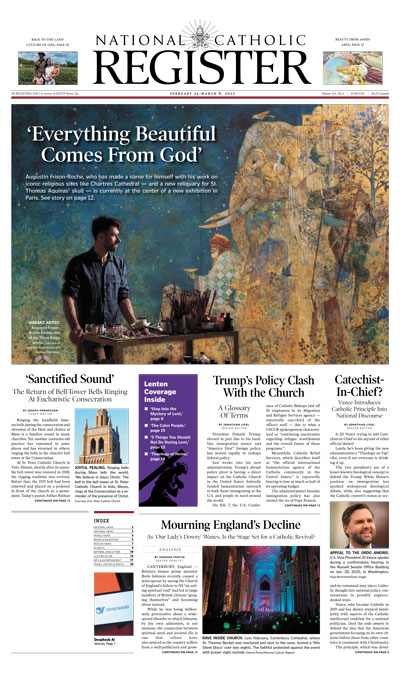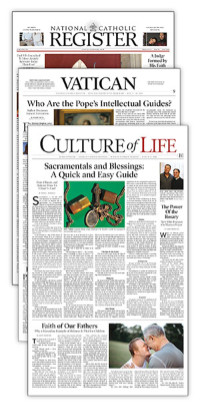Artist Kate Capato Turns Talent Into Mission to ‘Bring God Through Beauty to Others’
‘The encounter with authentic beauty is an encounter with the Lord, whether it’s just a small piece or the fullness of it, Christ himself.’

“It kept being two different worlds for the longest time,” said Kate Capato of the journey to becoming a full-time sacred artist. “I’ve always felt called to do mission work. How can I use my gifts to share Christ? And it was a long journey to get to where I am today. I felt like art, my gift of painting, even dance, all my different artistic gifts, had to be separate from the faith.”
Today, Capato is a sacred artist, public speaker, and sacred dance choreographer, doing business as Visual Grace. She produces original works on commission for parishes, Newman Centers and private collections and tours the country with her husband and young son, speaking about sacred art and leading sessions of visio divina — a prayerful encounter with a piece of sacred art, similar to lectio divina, prayerful dwelling on a sacred text — with original works. She has also appeared on EWTN.
She spoke to the Register about the journey to arrive where she is today, the vision that inspires her work, and the role of beauty in transforming culture.
The Journey to Integration
From a young age, Capato found herself sensitive to the ugly aspects of contemporary culture — particularly to demeaning messages about the body that lead to objectification and a culture of sexual immorality.
“I’m not painting a picture that I was great. But I felt extra sensitive to these things. And I think it was a call to dive into what we’re truly made for,” she explained.
After graduating from high school, she chose to major in fashion design, but quickly learned that the “cutthroat” industry was not for her. A shift to art therapy, bringing together counseling and artistic practice, felt more aligned, but Capato still felt that she had not found her “particular calling.”
After college, Capato joined The Culture Project and traveled across the country to speak to students about the beauty of human dignity and the richness of the Church’s teaching on sexual ethics. Rather than lecturing or being judgmental, Culture Project missionaries share “the fullness of integrity — you are made for so much more, and you have the ability to live in that,” she explained.At the Culture Project, Capato’s artistic passions continued to be separate from her missionary work. Still, she was “sharing beauty in the form of the stories of the saints, the beauty of creation, the beauty of our bodies, the message of theology of the body.” And this message resonated with young people.
“I would see eyes light up,” Capato told the Register. “And that really lit a fire in my heart to keep going in that direction, fighting the lies that say we’re not good enough; we’re not made for this greatness.”
While working with the Culture Project, Capato was also dancing with a part-time company in Philadelphia. Her performance schedule took her to Florence, Italy, where she encountered the Sacred Art School Firenze, which offered a focus on oil painting under the general umbrella of sacred art. In a city steeped in sacred art, Capato “really started to see things zip together.”
Later, she spent two years studying sacred art in combination with theology at the Sacred Art School, also teaching classes on theology of the body. There, her mission became more clear: “I can paint about the Lord. I can paint about how he speaks to us and what that looks like, the mysteries of our faith.”
When Capato launched her business, Visual Grace, more than 15 years ago, “it stopped being these two different worlds,” Capato said. Her commissioned works are on display in parishes and Newman Centers throughout the country, as well as in private collections. The “Commissions” section of her website emphasizes that Capato’s works are intended as an aid to prayerful reflection and that Capato remains open to the Holy Spirit’s guidance throughout her work. As the website puts it, these works are “a collaboration of the Lord, Kate, and you.”

Beauty That Communicates
Capato’s work is profoundly influenced by Pope St. John Paul II’s theology of the body. In her study of sacred art, she has seen the profoundly transformative power that respectful depictions of the human body can have.
While in Florence, an acquaintance shared with Capato that she had struggled with pornography in the past. When Capato asked about the woman’s experience of the many depictions of the human form in Italian sacred art, she recalled that she replied, “It has been so healing to see the body in the right way.” Capato sees her work as a step in this direction: “We need to be reminded and shift back to what the right vision is.” (This includes her depictions of Adam and Eve, which include non-sexual nudity.)
Fittingly, another influence on Capato is St. Bernard of Clairvaux’s Commentary on the Song of Songs.
“It shows us the love story. It’s so easy for us to forget that God loves us. Even that phrase can feel cliché, right? But he treasures us and is in love with us. ... Really, every work points back to that in its own way.”
Capato’s paintings depict scenes from Christ’s Gospels and parables — the Prodigal Son, the Woman at the Well, Mary Magdalene’s Resurrection Encounter with Jesus in the Garden — as well as images of the saints, including St. Rose of Lima, Our Lady of Snows, St. Josephand the Angels, and St. Padre Pio. Capato also paints implied images from Scripture and tradition: an intimate scene between Mary, Joseph and Baby Jesus; Mary cradling Eve in her arms; one of the Wise Men holding Baby Jesus; Jesus and Joseph in the workshop.
She has been privileged to see her works bear fruit in the lives of others. A big part of Capato’s mission is traveling with her work, speaking about the power of beauty and leading sessions of visio divina — a prayerful encounter with a piece of sacred art, similar to lectio divina, prayerful dwelling on a sacred text. Her husband, Paweł Machura, a music therapist and guitarist, plays during the visio divina sessions. The goal, explained Capato, is to “soak the senses” in an experience that brings the soul closer to God. “As humans, we need that.”
At these events, audiences frequently experience an encounter with God through Capato’s work. “Recently, a woman shared that her husband passed away a couple years ago, and she was in tears sharing with me how she really felt the Lord saying he’s bringing beauty. Hope and beauty is coming from this. You could see that hope in her heart from that encounter.”
A priest who prayed with Capato’s painting The Tabernacle during one of her mission travels shared with Capato that “he was going through a lot of trials. And that painting encouraged him to offer it up, like Our Lady, how she gives and suffers for us, her children.” Through his meditation with Capato’s painting, the priest “was encouraged to keep fighting that good fight for his children as the pastor of his community.”

The Lord’s Guidance
Capato’s mission requires a robust prayer life. She spoke to the influence of the “Surrender Novena” in her spiritual life and day-to-day experience of traveling from place to place, now with a 1-year-old son.
“It’s basically about surrendering mental control of everything,” said Capato of the novena, whose refrain is, “Jesus, I surrender myself to you. Take care of everything.” Most recently, Capato called the prayer to mind when she and her family weren’t sure where they would spend the night while out on the road. She also keeps it at the forefront of her artistic process: “There are times where I have to learn to let go and let the art be run by the Holy Spirit, let him be the main artist. I try to bring that motto of surrender into my heart regularly.”
This desire to spread beauty throughout the world, and particularly through the Church, is something that Capato hopes will be contagious.
In a time when many churches lack sacred art, especially original art, she suggests that parishioners have a role. “If you’re thinking that you have a part to play, what does that look like? Maybe you say to your parish priest, ‘Can we bring some art in?’ Maybe it’s just lighting an idea in his heart.”
Whether or not people see themselves as artistic, she encourages them to ask, “What can I do to help bring God through beauty to others?” In a contemporary culture like our own, said Capato, “We need more, and we need you, whether you’re an artist or not.”
“We don’t see [beauty] a lot in modern culture because the evil one hates it,” said Capato. “The evil one wants it gone. He tries to shut it up the best that he can, but he’s not going to, because the Lord always wins.” Her life’s mission is fighting this spiritual battle through beauty. “The encounter with authentic beauty is an encounter with the Lord, whether it’s just a small piece or the fullness of it, Christ himself.”
- Keywords:
- sacred art
- catholic artists
- beauty
- role of beauty

















